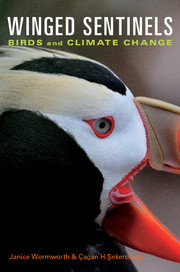Book contents
- Frontmatter
- CONTENTS
- ACKNOWLEDGEMENTS
- Introduction: The Free Advice of Birds
- Chapter 1 Phenology: Seasonal Timing and Mismatch
- Chapter 2 Migratory Birds Face Climate Turbulence
- Chapter 3 Range Shifts and Reshuffled Communities
- Chapter 4 Seabirds Herald Ocean Changes
- Chapter 5 Climate Change, Abundance and Extinction
- Chapter 6 Tropical Warming and Habitat Islands
- Chapter 7 Shifting Ground on Conservation
- NOTES
- INDEX
- PLATE SECTION
- PLATE SECTION
- PLATE SECTION
Chapter 1 - Phenology: Seasonal Timing and Mismatch
Published online by Cambridge University Press: 05 March 2012
- Frontmatter
- CONTENTS
- ACKNOWLEDGEMENTS
- Introduction: The Free Advice of Birds
- Chapter 1 Phenology: Seasonal Timing and Mismatch
- Chapter 2 Migratory Birds Face Climate Turbulence
- Chapter 3 Range Shifts and Reshuffled Communities
- Chapter 4 Seabirds Herald Ocean Changes
- Chapter 5 Climate Change, Abundance and Extinction
- Chapter 6 Tropical Warming and Habitat Islands
- Chapter 7 Shifting Ground on Conservation
- NOTES
- INDEX
- PLATE SECTION
- PLATE SECTION
- PLATE SECTION
Summary
A harmless pastime illuminates a present danger
…birds fly with song and glancing plumage, and plants spring and bloom, and winds blow, to correct this slight oscillation of the poles and preserve the equilibrium of Nature.
Henry David Thoreau, 1854The meticulous notes of yesteryear's naturalists are helping today's scientists bolster one of the most powerful demonstrations of climate-change effects on the living world. In 1841, when Henry David Thoreau was strengthening his resolve to live alone in the woods, he wrote in his journal, ‘But my friends ask what I will do when I get there.’ Thoreau answered with his own question, ‘Will it not be employment enough to watch the progress of the seasons?’
Observations echoing this simple and timeless desire are found in his book, Walden, a record of life in his one-room cabin at Walden Pond near Concord, Massachusetts. ‘I was startled by the loud honking of a goose,’ he wrote of one early winter night, ‘and, stepping to the door, heard the sound of their wings like a tempest in the woods as they flew low over my house.’ Yet Thoreau's observations on seasonal change went beyond mere poetic musings. ‘I take infinite pains to know all of the phenomena of the spring,’ he wrote in his journal in 1856. His detailed records, jotted down in tables drawn on large sheets of surveyor's paper, are now proving invaluable to efforts to document the biological response to climate change.
- Type
- Chapter
- Information
- Winged SentinelsBirds and Climate Change, pp. 9 - 32Publisher: Cambridge University PressPrint publication year: 2011



